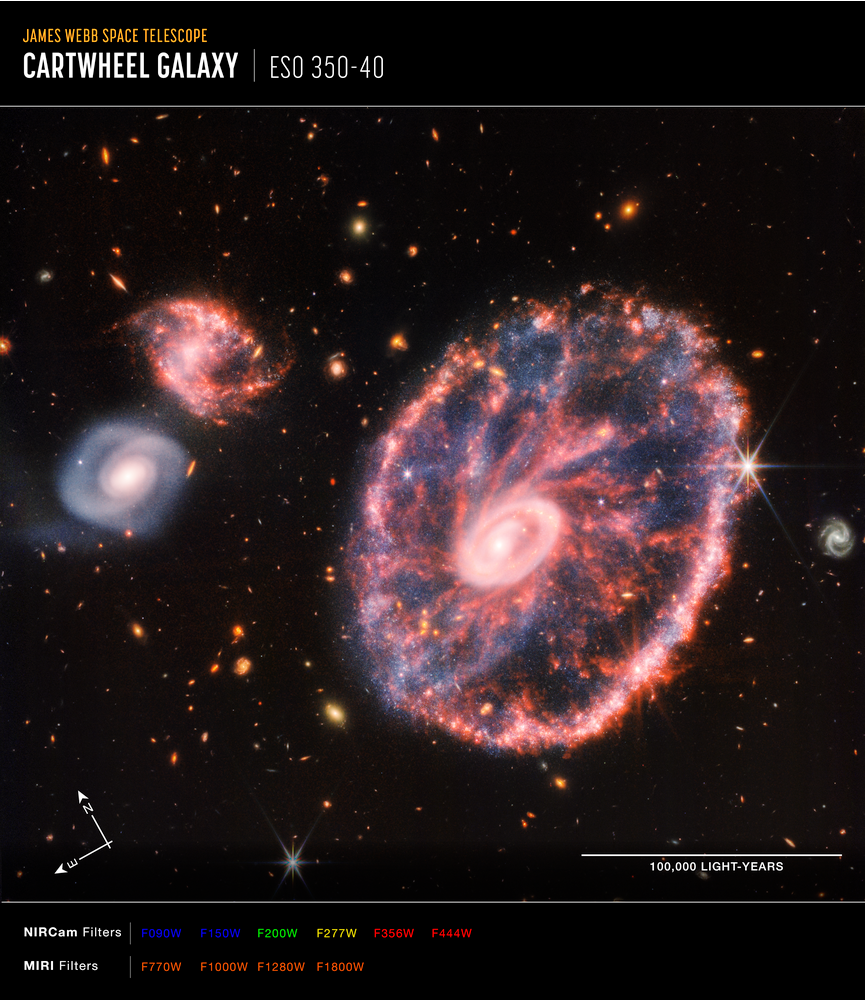
This image of the Cartwheel and its companion galaxies is a composite from Webb’s Near-Infrared Camera (NIRCam) and Mid-Infrared Instrument (MIRI), which reveals details that are difficult to see in the individual images alone.
This galaxy formed as the result of a high-speed collision that occurred about 400 million years ago. The Cartwheel is composed of two rings, a bright inner ring and a colorful outer ring. Both rings expand outward from the center of the collision like shockwaves.
However, despite the impact, much of the character of the large, spiral galaxy that existed before the collision remains, including its rotating arms. This leads to the “spokes” that inspired the name of the Cartwheel Galaxy, which are the bright red streaks seen between the inner and outer rings. These brilliant red hues, located not only throughout the Cartwheel, but also the companion spiral galaxy at the top left, are caused by glowing, hydrocarbon-rich dust.
In this near- and mid-infrared composite image, MIRI data are colored red while NIRCam data are colored blue, orange, and yellow. Amidst the red swirls of dust, there are many individual blue dots, which represent individual stars or pockets of star formation. NIRCam also defines the difference between the older star populations and dense dust in the core and the younger star populations outside of it.
Webb’s observations capture the Cartwheel in a very transitory stage. The form that the Cartwheel Galaxy will eventually take, given these two competing forces, is still a mystery. However, this snapshot provides perspective on what happened to the galaxy in the past and what it will do in the future.
NIRCam was built by a team at the University of Arizona and Lockheed Martin’s Advanced Technology Center.
MIRI was contributed by ESA and NASA, with the instrument designed and built by a consortium of nationally funded European Institutes (The MIRI European Consortium) in partnership with JPL and the University of Arizona.
Credits
Image
NASA, ESA, CSA, STScI, Webb ERO Production Team
| About The Object | |
|---|---|
| Object Name | Cartwheel Galaxy, ESO 350-40, AM0035-335 |
| Object Description | Interacting Galaxies |
| R.A. Position | 00:37:41.09 |
| Dec. Position | -33:42:59.0 |
| Constellation | Sculptor |
| Distance | 500 million light-years (150 Mpc) |
| Dimensions | Image is 2.34 arcmin across (about 340,000 light-years) |
| About The Data | |
| Data Description | This image was created with Webb data from proposal: . It is part of Webb Early Release Observations. The Early Release Observations and associated materials were developed, executed, and compiled by the ERO production team: Jaclyn Barrientes, Claire Blome, Hannah Braun, Matthew Brown, Margaret Carruthers, Dan Coe, Joseph DePasquale, Nestor Espinoza, Macarena Garcia Marin, Karl Gordon, Alaina Henry, Leah Hustak, Andi James, Ann Jenkins, Anton Koekemoer, Stephanie LaMassa, David Law, Alexandra Lockwood, Amaya Moro-Martin, Susan Mullally, Alyssa Pagan, Dani Player, Klaus Pontoppidan, Charles Proffitt, Christine Pulliam, Leah Ramsay, Swara Ravindranath, Neill Reid, Massimo Robberto, Elena Sabbi, Leonardo Ubeda. The EROs were also made possible by the foundational efforts and support from the JWST instruments, STScI planning and scheduling, Data Management teams, and Office of Public Outreach. |
| Instrument | MIRI, NIRCam |
| Exposure Dates | 10-11 June 2022 |
| Filters | NIRCam> F090W, F150W, F200W, F277W, F356W, F444W MIRI> F770W, F1000W, F1280W, F1800W |
| About The Image | |
| Color Info | These images are a composite of separate exposures acquired by the James Webb Space Telescope using the MIRI and NIRCam instruments. Several filters were used to sample narrow and broad wavelength ranges. The color results from assigning different hues (colors) to each monochromatic (grayscale) image associated with an individual filter. In this case, the assigned colors are: Red: F444W + F356W Orange: F770W + F1000W + F1280W + F1800W Yellow: F277W Green: F200W Blue: F150W + F090W |
| Compass Image |  |
| About The Object | |
|---|---|
| Object Name | A name or catalog number that astronomers use to identify an astronomical object. |
| Object Description | The type of astronomical object. |
| R.A. Position | Right ascension – analogous to longitude – is one component of an object's position. |
| Dec. Position | Declination – analogous to latitude – is one component of an object's position. |
| Constellation | One of 88 recognized regions of the celestial sphere in which the object appears. |
| Distance | The physical distance from Earth to the astronomical object. Distances within our solar system are usually measured in Astronomical Units (AU). Distances between stars are usually measured in light-years. Interstellar distances can also be measured in parsecs. |
| Dimensions | The physical size of the object or the apparent angle it subtends on the sky. |
| About The Data | |
| Data Description |
|
| Instrument | The science instrument used to produce the data. |
| Exposure Dates | The date(s) that the telescope made its observations and the total exposure time. |
| Filters | The camera filters that were used in the science observations. |
| About The Image | |
| Image Credit | The primary individuals and institutions responsible for the content. |
| Publication Date | The date and time the release content became public. |
| Color Info | A brief description of the methods used to convert telescope data into the color image being presented. |
| Orientation | The rotation of the image on the sky with respect to the north pole of the celestial sphere. |